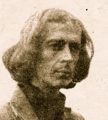
All the pictures selected below, apart from numbers 1 to 4, are now in private or public collections. There are numerous other works, such as the 1963 view of the Tyne above, that were important at the time of painting, though, like the above, might represent just a few moment’s pause on a walk. Those reproduced below represent considerably more prolonged undertakings.
Carl Jung wrote: ‘Being essentially the instrument of his work [the artist] is subordinate to it, and we have no right to expect him to interpret it for us. He has done his utmost by giving it form, and must leave the interpretation to others and to the future.’
(C. G. Jung, ‘Modern Man in Search of a Soul’, tr. Cary F. Baynes 1961)”
What is most interesting in a painting is often that which was the least foreseen or intentional (not so much the ‘untended’ as the ‘unintended’!) What I have written is not an attempt at self-interpretation, just a few contextual observations or recollections – which the reader is welcome to ignore.
1. NEAR CHIPPS COMMON, WHEELER END, BUCKS. Oil on hardboard, 1962

This rather apocalyptic-looking painting was done from a pencil sketch made on a walk in Buckinghamshire. Having obtained the Intermediate Diploma at Hornsey College of Art, and anticipating entering the painting school to study for the N.D.D. next term, I worked at home on this picture during the summer holiday. I took the picture into College, where it was then exhibited on a corridor wall for the remainder of my time at the college. (Maybe they’ve still got it…?)
2. THE EXPULSION FROM THE GARDEN OF EDEN – Oil on canvas 4’x6′ 1961 – 2

This picture, which was exhibited in the 1962 Young Contemporaries exhibition at the RBA galleries in Suffolk Street, London, is in a symbolist manner reflecting my more introspective interests at the time – cultural heavyweights such as Richard Wagner, William Blake and Carl Jung. The dawn of human consciousness is conveyed by the open eye and the rising sun. The telegraph pole, barely visible near the left hand edge, may imply transmission of hidden knowledge, or just a nod to Eric Ravilious.
Reportedly, at the Y.C. Forum Anthony Caro singled out this painting for favourable comment – possibly because it stood aloof from the prevailing ‘Pop Art’ manner.
3. The Greenhouse, Hornsey College of Art, Oil on canvas 42″ x 34″ 1962
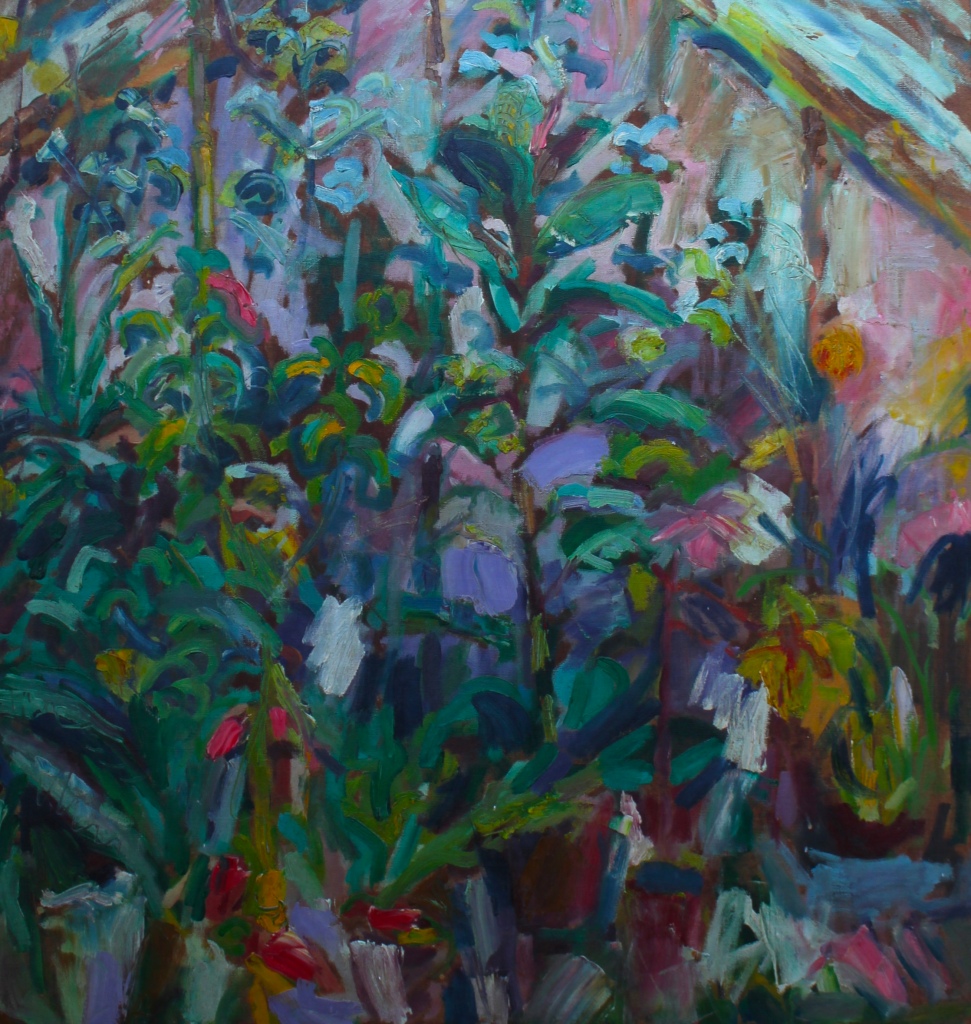
I enjoyed the freedom of painting in the Art College greenhouse – away from the discipline of the life room! At the same time I wanted to work more from direct observation. Towards the end of the summer holiday I’d had a cycling accident and a fortnight in hospital, which perhaps influenced this change of attitude. Back at College my first greenhouse painting was modestly observational. >

4. A BACK GARDEN IN CROUCH END oil on canvas 40″x60″ 1962

When I painted this view of our back garden in Crouch End- in just one session – I saw it as an uncomplicated, direct response to the scene. One of our tutors, John Wormell, enthused that the composition worked principally in terms of colour. As mentioned elsewhere on this site, the work was awarded the ‘Sketch Club Prize’ at Hornsey Art College.
5. CHIPPS COTTAGE, Oil on hardboard, 1970.

As in life, colour is an energetic force in a painting, even if the intention is merely descriptive. Our exciting first glimpse, as we got off the bus at Wheeler End Common, was the chimney of Chipps Cottage and the smudge of pink-brown roof among the trees. Our holidays there were important to my family from as long ago as I can remember. When the cottage was sold in about 1980 it was the end of an era.
6. THE ORCHARD, CHIPPS oil on board 40″x50″, 1974.

Beyond the darkness of the enclosing hedge, the land slopes away, and one can see through it the blue, humid glint of a valley of chalk downland – it is typical of Chiltern countryside that the valleys are enclosed spaces of chalk grassland, while the hilltops are crowned with extensive beech woods, scattered villages and common land.
The meadow-like orchard would be scythed at midsummer, but in May, when I painted this scene, the grass was lush, the apple was in blossom, there were a few lingering bluebells among the grass, and a creamy-white topping of cow parsley. Most important was the grass; the rhythm of its interplay with light, the beautifully curved plane of each blade offering its utmost surface to the sun and moist air.
At the time I had little sense of it being a success, yet I find that in my subsequent work, despite changes in vision and technique, I still refer to this painting in the back of my mind.
7. CHIPPS ORCHARD Oil on board, 24″ x 32″ 197?

Although the grass is once again claiming my attention, this seems almost a picture of nothing; just a place and a space. This painting in particular may have been important to me, but the whole experience of staying at Chipps and going walks in the Chiltern countryside, gave impetus to my outdoor drawing and painting.
8. A NEGLECTED GARDEN, STOKENCHURCH. oil on hardboard 20″x30″ 198?

Painted in the forgotten garden of a former inn at Stokenchurch, Buckinghamshire, maybe pursuing the theme of long grass – though obviously the Ox Eye Daisies predominate.
9. BEECH WOODS, Buckinghamshire 197Os acrylic on hardboard, 48″x36″

Painted in a beech wood near West Wycombe, staying at the former inn mentioned above, I was very conscious of the work becoming quite detailed. Its supposed ‘realism’ caused a bit of a stir when it was first exhibited – at the opening of a friend’s newly-built wine store. But, for me, it isn’t a total success.
10. BLACKBERRIES IN AUGUST, MUSWELL HILL Acrylic on panel 36″X48″ 1980.

I had permission to paint this garden in August 1980, while its owners were away in France – I was looking for a subject with long grass. They had told me they seldom mowed their lawn – though clearly it’s the brambles that are more out of control!
Working seven or eight hours a day, I completed the picture in four weeks – at that time the longest I’d ever spent on a single painting! The foreground brambles grew rapidly and I paid increasing attention to them.
The painting won a prize in the Greater London Council ‘Spirit of London’ Exhibition at the Royal Festival hall in 1980 – the visiting judge being Frank Auerbach. It is now in the permanent collection at London’s Guildhall Art Gallery. It was also exhibited in 1982 in Hornsey College of Art’s exhibition ‘A Century of Art Education, 1882 -1982’, held at Hornsey Library.
I have received more feedback from people looking at this painting than any other of my pictures. I imagine them sitting in the Guildhall Gallery looking at the picture and writing to me on their smartphones at the same time.
11. CLEMENT’S GARDEN oil on canvas 48″x36″ 1986.

Initially attracted by the long grass and the dandelions, I began this painting in my friend Clement Griffith’s garden in Whitehall Park, Highgate in April 1986. The Chernobyl disaster was in the news and I wondered whether the heavy spring rain falling on the garden was affected by the nuclear cloud. But as time passed, there was nothing abnormal; the dandelion flowers became clocks and horse-chestnut leaves came to dominate the composition.
I noted the warmth of colour from the undersides of the leaves, compared to the cold light glancing from their upper surfaces. This isn’t just light defining passive material but light in a biochemical interaction – the leaves are ‘eating the sun’.*
The picture was exhibited in the Royal Academy in 1987 and privately purchased. In 2004 it was loaned for inclusion in Tate Britain’s feature exhibition ‘Art of the Garden’ .
*’Eating the Sun’ by Oliver Morton, Fourth Estate 2007
12. Clement’s Garden in Winter; Acrylic on board, approx 8″x6″

I don’t remember what prompted me to paint this aspect of Clem’s garden, possibly in the New Year – I forget which year! The garden slopes steeply up and has a series of levels, the topmost affording a view over the rooftops. This view is the reverse of the previous picture (No 11 above) having been painted from the garden door, looking up towards the fence at the top.
13. GARDEN IN NORTH LONDON oil on canvas 3’x4′ circa 1992

This is the first of many works I painted in the garden of my friend and colleague Jackie Baker. She is a nature lover, who maintains the garden in a semi-wild state. Backing on to Alexandra Park in North London it is home to nightingales, woodpeckers, and hedgehogs as well as familiar wild plants.
14. HERBE FOLLE oil on canvas 4′ x 5’4″ 2000

The edges of the Normandy estate of Les Bouillons, painted with themes of Marcel Proust in mind, hence the mid-distance glimpse of Hawthorn in flower.
The painting was exhibited at the Francis Kyle Gallery exhibition ‘The Art of Memory’ and subsequently at the National Theatre, London, to coincide with the staging of a screenplay by Harold Pinter based on Marcel Proust’s ‘A La Recherche du Temps Perdu‘.
Apart from some genuine connections between this part of Normandy and Proust’s famous novel the painting is essentially a record of what the Les Bouillons artist & curator André referred to as an ‘immersion’ in nature. The title was suggested by the Les Bouillons residents.
15. BRAMBLES IN A NORTH LONDON GARDEN oil on canvas 40″x30″, 2001.
Drawing or painting from observation is never outdated. It is the ‘perennial philosophy’ of visual art.

When drawing or painting from direct observation one tries to put aside all preconceptions about appearances and to work in the here and now. In painting this picture – again in Jackie Baker’s garden – it struck me, like an unexpected coincidence, that while I am using light in a visual medium to explore the plants, they themselves are using the same energy – the cold light of day as much as the warm sunlight – in photosynthesis, upon which the ecology, economy, culture and consciousness of the whole planet depends, including my ability to be here painting them.
That sense of reciprocal involvement with blackberries, biochemistry and daylight, is a hidden theme in this painting, unifying the other linked aspects.
‘Brambles’ was initially exhibited in the first of my one-man shows at the Francis Kyle Gallery in 2002, and in 2007 at The Geffrye Museum, London (now renamed ‘The Museum of the Home’) in the exhibition ‘Home and Garden: Paintings and Drawings of English, middle-class, urban domestic spaces 1914 to 2006’. The curator, Christine Lalumia, wrote about my painting: “This is suburbia gone wild, a hidden world behind the neat facades of the houses. Indeed, there is something ambiguous about this picture…..the garden is so overgrown that the boundaries have disappeared, making it seem infinite. On the other hand, the garden is literally an enclosed refuge. The contradiction creates a tension: are we trapped in the undergrowth or unbounded and free in this wild garden?“
16. THE TREE HOUSE, oil on canvas 3’x4′

This painting was subject to a common misfortune of outdoor painting – a gust of wind blew it off the easel and on to a sharp corner of stonework, tearing the canvas. Luckily I knew a picture restorer able to make an invisible repair.
It’s not unknown for my painterly concentration to be interrupted by a gust of wind sending the canvas cartwheeling across the landscape. I sometimes suspect there are hidden forces opposed to any honest endeavour, and If so, such setbacks must be seen as encouraging!
17. AN OVERGROWN ROCKERY also entitled ‘Saint Saviour Church, Muswell Hill, London’, oil on canvas 4’x3′ painted in a ‘well neglected’ north London garden.

Saint Saviour Church, looming in the background of this painting, was due for demolition. I was told it was gradually sliding down the muddy hillside. Built between 1903 and 1909, more or less contemporary with the surrounding houses, it was pulled down in 1994, some years after this painting was completed.
The garden slopes up to a row of trees, beyond which is the deer park of Alexandra Palace in North London. The water mint, flowering in the immediate foreground, shows the damp conditions that also affect this garden.
This garden is an ever changing subject for paintings, which Jackie Baker has kindly made available to me over many years. It is too large to keep fully cultivated, and Jackie’s interest in natural history also inclines her to keep at least some of it in what I’ve called a ‘well neglected’ state.
My painting advocates the quiet anarchy of a ‘hands off’ approach, yet strictly speaking there isn’t such thing as a ‘wild garden’: the human world is ever-present as a background, or environment, one way or another predisposing nature’s free expression. Here, the ‘rockery’ is overgrown with wild species such as mint, rosebay and bramble.
This painting, under the title ‘Saint Saviour church, Muswell Hill, London’ is on display at the Nature in Art museum, Gloucester: Nature in Art, Wallsworth Hall, Sandhurst Lane, Twigworth, Gloucester, GL2 9PA. Direct tel: 01452 733942 Tel: 01452 731422 http://www.nature-in-art.org.uk
18. MIDSUMMER oil on canvas 32″x24″ 2005

This is another rendering of Jackie Baker’s garden in north London, showing a profusion of wild plants and cultivated varieties. (St. Saviour church no longer looms on the skyline!) The painting was begun in May and finished at the height of summer.
19. A WALLED GARDEN oil on canvas 30″x40″, 1999, of the former vegetable garden of a small farmhouse in La Trancardière, Normandy.
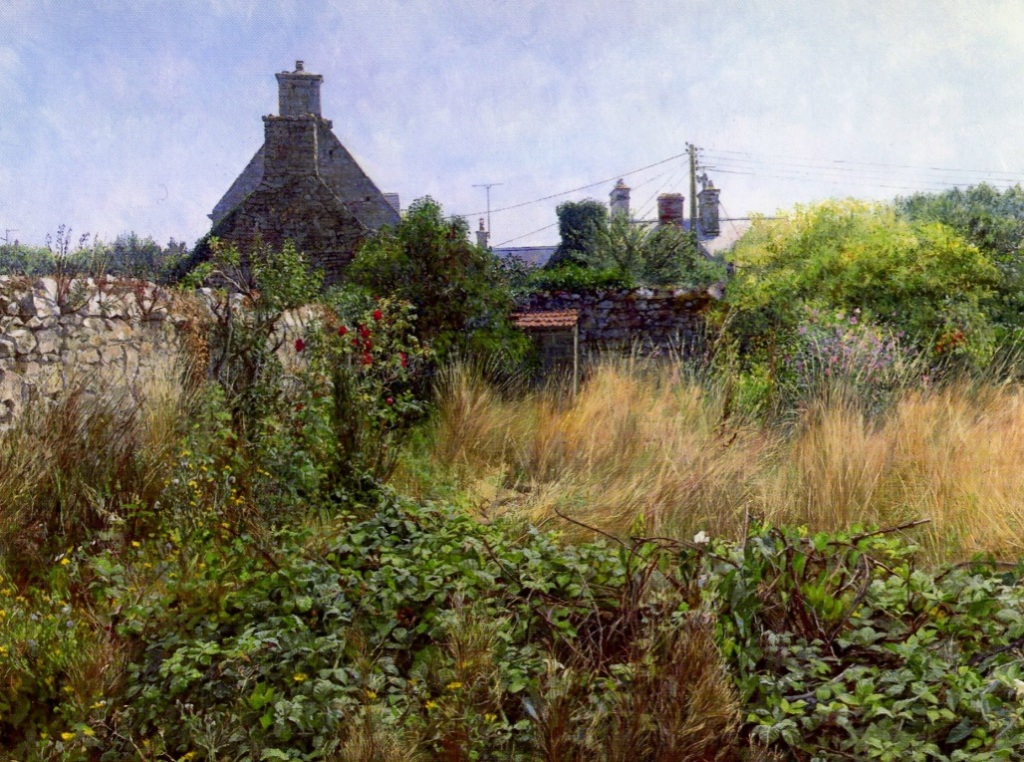
This was painted over many weeks, getting to work in the early morning, but stopping as soon as the sun started to shine on the gable end.
Though every detail was a product of fairly intense scrutiny and decision, I have almost no memory of doing any particular part of the picture, and can hardly believe that I did it. This is not meant to sound clever, simply a fact – in some ways a painting paints itself.
Below: an early stage of the work –

20. WILD PLANTS, NORMANDY oil on canvas 4’x 5’4″ 2007.

A study of plants in the Normandy bocage growing in a hidden world of profusion. I regard this as one of my best paintings, though it was sold before I was able to get a good photo of it.
My representation of nature could be termed ‘realist’, but I admire Jackson Pollock’s masterpieces, and the sort of composition I favour is definitely post-cubist. That gives scope to a more subtle interplay of the physical surface of the painting with spatial illusion. I am painting on my feet, composing the scene from slightly changing angles. As Harold Rosenberg wrote of abstract expressionism, what goes on the canvas is ‘not a picture but an event’ (ARTnews Dec 1952 quoted by Martin Gayford 2018)
I worked on the edge of woodland looking across a more open wetland area in which many of the plants are growing to higher than eye-level. Water-mint is identifiable in the immediate foreground, along with nettles. Also Hemlock Water Dropwort – one of Europe’s most poisonous indigenous plants (but only if you eat it!). This is a community of wild plants, quietly getting on with the task of carbon sequestration, from which we all benefit.
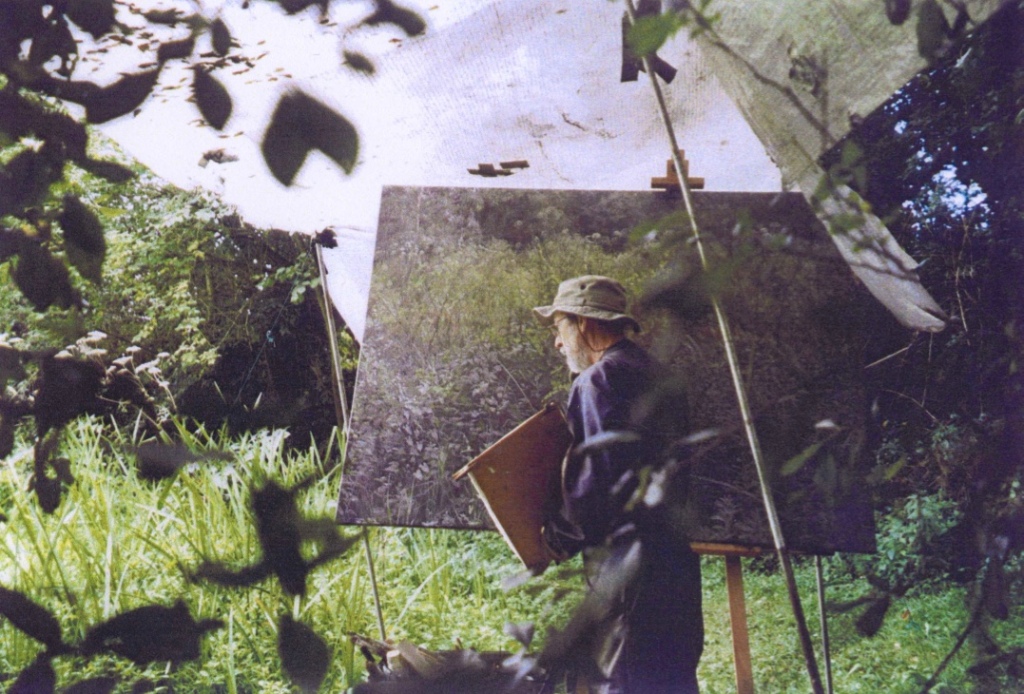
21. LA SIENNE oil on canvas 4’x5’4″ 2001. A wild upper reach of a river in Lower Normandy.

I remember the moment when I came upon this scene as a sudden expanse of light – seeming like a moment of self-realisation! I had to paint it! Hidden behind copses, the river widens to a pool below a rocky cataract, and seems to exist in its own world. At first rather daunted by the moving water, I made some preliminary studies, including this 15″x20″ canvas:
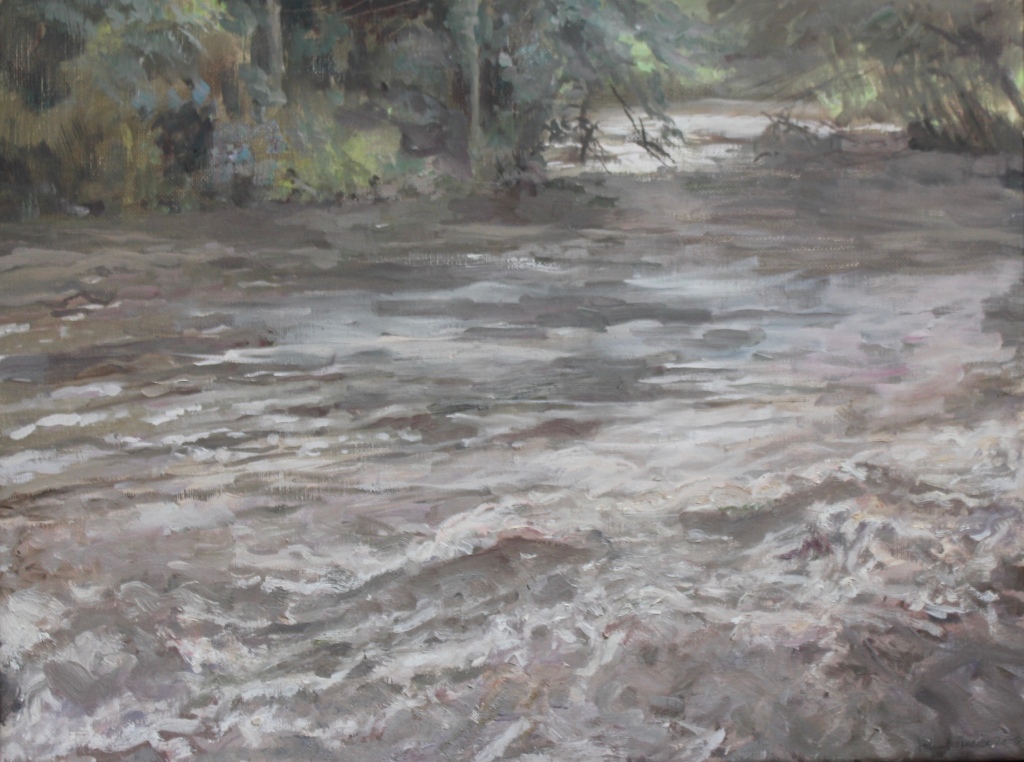
It was November, and after heavy rain, the river valley became a lake. But, as with other French rivers, its flow was being regulated by sluice gates. I often approached the site wearing waders and using a ladder to bridge hidden dykes. The painting took many weeks and frolicking otters got quite used to my presence.


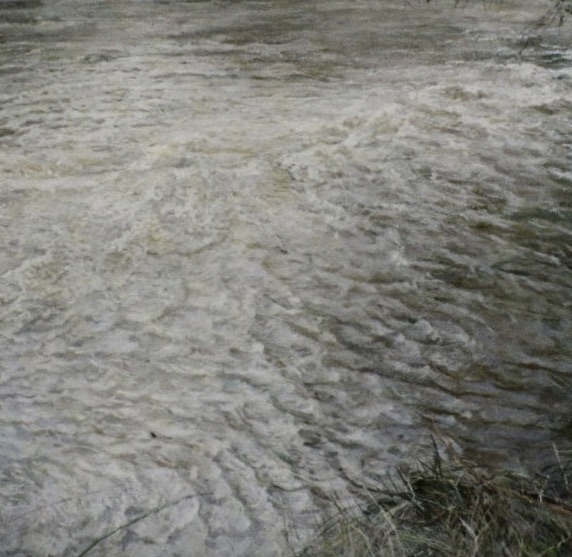
22. MEADOW NEAR ORVAL, NORMANDY – oil on canvas 4’x6′

Another ‘painting of nothing’ I suppose – the subject is as much the painting itself as what it purports to depict. (The essayist William Hazlitt dismissed Turner’s experiments with atmospheric effects as “pictures of nothing, and very like”. As Michael Prodger, the Guardian critic comments “They may indeed be paintings of the immaterial, but they are also evidence of Turner’s search for the numinous.”)
23. LES BOUILLONS – two works, one in the morning, the other in the evening, 1995… painted over the same period of time in early summer, 1995, each on a 4’x 3′ canvas
Les Bouillons Evening

I worked on the two paintings over the same period of time. To me the evening picture in particular evokes both the beauty of the place and happy memories.
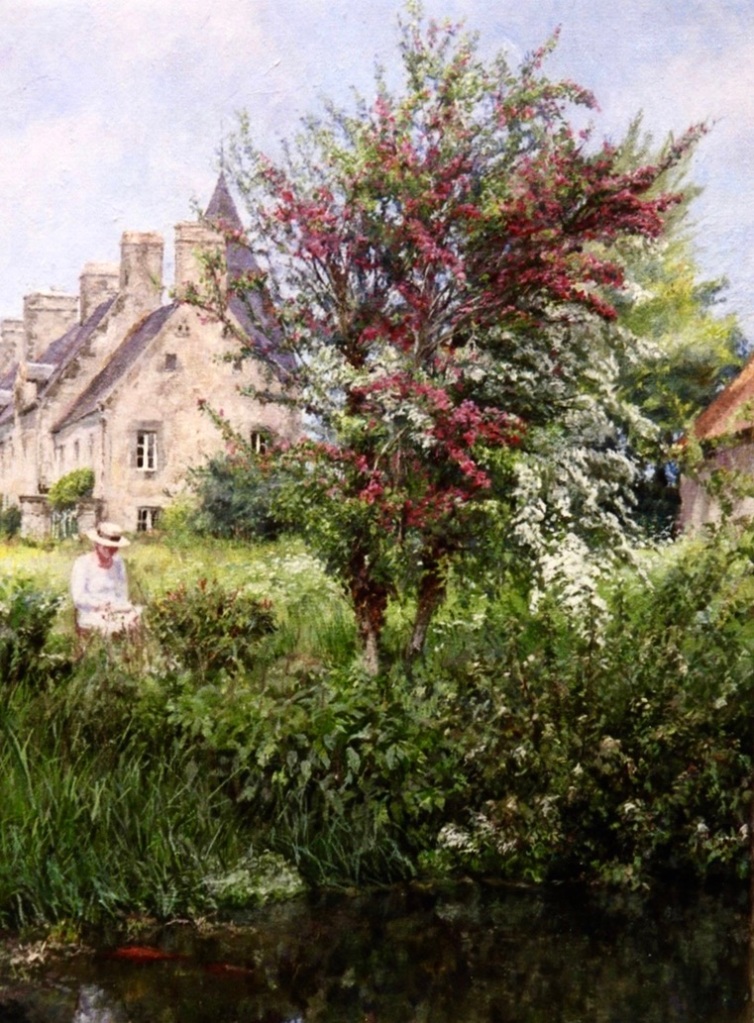
An exhibition of Tanqueray’s work was held aux Bouillons in September 2023
One of my neighbours in Regnéville, Sylvain Letenneur, took me to ‘Les Bouillons’, an estate near Orval in Lower Normandy, and introduced me to his Great Aunt Mimi and others of his relatives, the Saussaye and the Gemin families. Being artistically inclined themselves, they welcomed me to paint on the estate. From Julie Saussaye I learned that ‘l’ancêtre‘, one Achille Tanqueray, a 19th C. artist and collector, had accumulated works by Jean-Léon Gérôme at a time when that once celebrated academic painter and École des Beaux-Arts professor was unfashionable. When interest in Gérôme later revived he was able to sell his collection to The Louvre, and then acquired Les Bouillons – at the time a productive farm – where he established his own studio.

Les Bouillons, Morning.
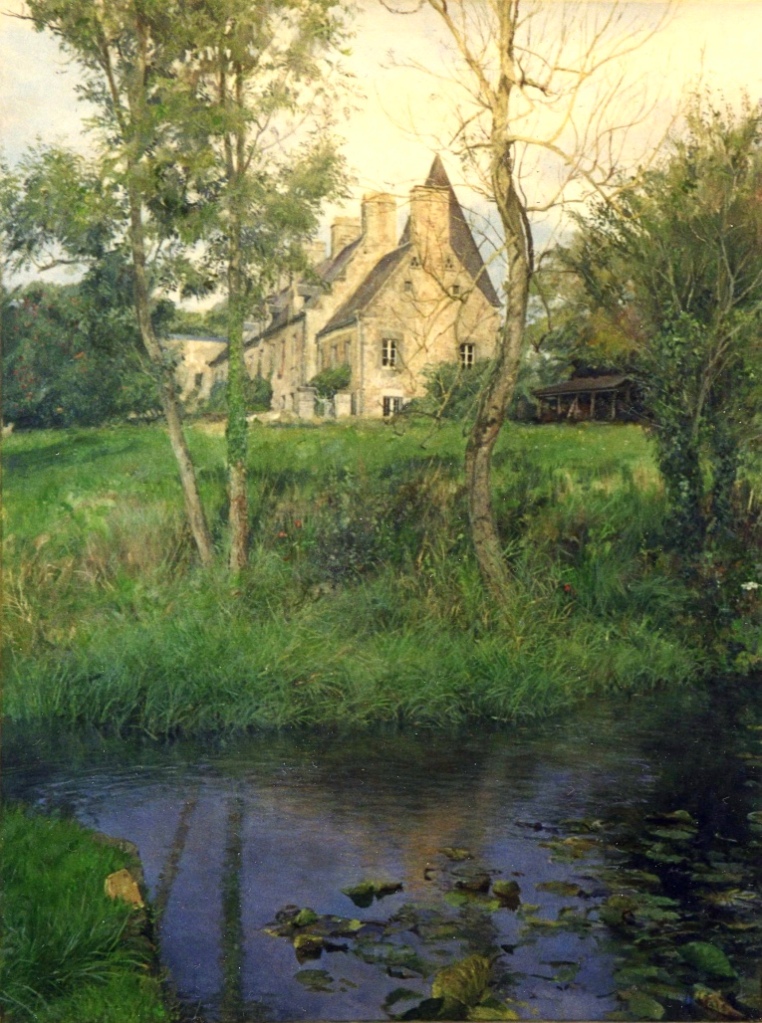
24. THE FISHPOOL, LA FOUBERDIÈRE, GRATOT, NORMANDY oil on canvas 4′ x 5′ 4″ 2005

It is unusual for me to include a quickly moving creature such as a fish; to do so is to freeze a single moment, whilst the painting as a whole distils a far longer span of time. The golden carp, and a less conspicuous native species in the shallows, frequented this area of pond in the last weeks of work on the painting and seemed to demand inclusion!
25. COW PARSLEY, ORVAL oil on canvas 40″x30″ 2005

Knowing his literary background, I always included notes, such as these, with each picture I submitted to Francis Kyle. “According to the environmentalist Richard Mabey (Flora Britannica 1996) ‘Cow Parsley is arguably the most important spring landscape flower'”. In May time it is as ubiquitous as Hawthorn. Geoffrey Grigson (The Englishman’s Flora 1958) refers to Cow Parsley as a ‘plant of lace and moonlight’ and notes traditional associations with the devil and witchcraft.
This is another Les Bouillons painting. ‘Persil de vache’ in French…? In English, the name ‘Queen Anne’s Lace’, despite its genteel appeal, has never quite caught on. ‘Cow Parsley’ may well mean an inferior form of Parsley, yet association with cattle is appropriate to a flower of May, when the sun enters the zodiac sign of Taurus, the bull, whose upturned horns may be those of the new moon in this most fertile month.
Growing on the verges of country lanes, Cow Parsley usually gets mowed before I have time to paint it. On this occasion I prevailed on the Les Bouillons folk to hold off till I finished the picture.
In the catalogue note of my 2005 exhibition, Francis Kyle referred to this painting as ‘vertiginous’, and writes perceptively of the ‘springy, textural density’ achieved by the brushwork, distinguishing the technique from more traditional approaches to realism in the way ‘the action of painting becomes identical with the subject’. As with my 1970s paintings of ‘Chipps Orchard’, the grass is important to the composition.
26. THE PATH HALF-LOST oil on canvas, 24″x18″, 2010

This painting was exhibited in ‘This Twittering World’, an exhibition at the Francis Kyle Gallery in 2011 with a theme of T. S. Eliot’s Four Quartets. The Literary context here is optional, though not misleading.
I wrote the following description for Francis: “‘The Path Half Lost’, shows an oblique view of a garden path surrounded by overgrown flowerbeds, with wild and cultivated plants: Hellebore, Buttercup, Nettle, Dock, Rosebay and Wild Geranium. The viewpoint from beside the path could suggest a point outside of time.
I had in mind the phrase from Eliot’s poem: ‘Into our first world’
It seemed to me that in Burnt Norton The garden represented the poem itself. Within it Eliot contemplated personal memory, but also ‘other echoes’, from a cultural universe inhabited by both reader and poet. Like Dante, he has lost his path in a dark wood, and, like Orpheus, he negotiates a shadowy world of hints and suggestions by means of his art.
Eliot and his American friend Emily Hale had lost their way, on a woodland walk in Gloucestershire in 1934, when they strayed into the garden of Burnt Norton Manor. The poem conveys a heightened awareness under the eyes of unseen observers: leaves full of children, unheard music in the shrubbery, and trepidation appropriate to holy ground. Out of the formality and aridity of a drained concrete pool ‘the lotos rose’, and the poet glimpses a mirage of the absolute. The vision fades, and a bird urges them to leave, because ‘humankind cannot bear very much reality’.
Eliot completed the Four Quartets during his time as a fire warden in the Second World War. Like his, my own work has autobiographical and historical echoes. I was born in North London near the end of the Second World War, and the vivid glow of childhood recollections is set against that sombre background: playing at the edges of my father’s allotment, or later, on the bomb sites which nature had regenerated with reassuring biodiversity.
There may be few parallels in poetry to T. S. Eliot’s tone of meditative soliloquy in Four Quartets, but I have found that painting can follow a comparable path in a quest for ‘the point of intersection of time and the timeless’.”
27. A NORTH LONDON GARDEN Oil on canvas 4’x3′ 2010

Another painting done at Jackie Baker’s garden. All I can remember about this is finding the perspective of the foreground brickwork unexpectedly subtle – in particular the geometry of the horizontal square surface. The relationships change as I bob around mixing colour or lean forward to apply a brushstroke. I have not tried to attempt some form of cubist painting, so the drawing implies an unchanging point of view, whereas my eye-line changes constantly as I peer into the depths of the garden.
28. Joch – A Village in the Pyrenees. Oil on canvas 4’x 5’4″

On a walk, following a mountain stream, I discovered the hilltop village of Joch. I was immediately struck by the almost shocking contrast of newer building, serene ancient stonework and blue distance. I found a painting position on the opposite slope.

29. L’ORIGINE Oil on canvas 4′ x 5′ 4″, painted in a wild, secluded Normandy estate, ‘La Fouberdière’, from May 1st to August 1st 2014, and exhibited in the Conciergerie, Château de Regnéville Sur Mer, Normandy from 15th – 20th August the same year.

The title, L’origine’, could equally be ‘L’énigme’, since understanding the world is always an unfinished task.
Just as I was finishing this painting, Francis Kyle, my artistic agent for the last decade and a half, rang up to announce the imminent closure of his gallery in Maddox Street; consequently the painting was first exhibited in Normandy in the Conciergerie of the Château de Regnéville Sur Mer, alongside works by Gerry Keon, Susan Herivel and John Richter. (See EXHIBITIONS) Among the visitors to the exhibition was Jean-Pierre Lavaud, a lecturer and writer on philosophy. In context of this picture , he cited the existentialist/phenomenologist Merleau-Ponty, who liked to quote Husserl’s ‘Cartesian Meditations’: “It is experience…as yet wordless, which needs to be brought to a pure expression of its own meaning.”
